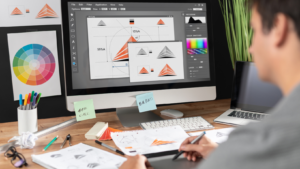Design isn’t just about making things look good; it’s about creating experiences that engage and inspire. Whether you’re a seasoned designer or just starting out, mastering a few essential tips and tricks can elevate your work to new heights. From understanding the psychology of color to leveraging the power of white space, these insights can transform your approach to design.
Design Tips and Tricks
Employing specific design tips and tricks can elevate an average design to an exceptional one. This section delves into essential aspects that every designer should consider.
The Importance of Composition
![]() Composition affects the overall balance and harmony of a design. An effective composition guides the viewer’s eye, ensuring that the design communicates its intended message clearly.
Composition affects the overall balance and harmony of a design. An effective composition guides the viewer’s eye, ensuring that the design communicates its intended message clearly.
- Rule of Thirds: Divide the canvas into a 3×3 grid. Place key elements along these lines or at their intersections to create a balanced and engaging design.
- Hierarchy: Organize elements by their importance. Use size, color, and placement to help viewers understand the sequence of information.
- Proximity: Group related items together. This helps users associate these elements with each other, reinforcing their relationship.
Typography Ideal Practices
Typography plays a crucial role in readability and aesthetics. Proper use of fonts can enhance the visual appeal and effectiveness of a design.
- Font Selection: Choose fonts that align with the brand’s identity. Use no more than two or three fonts to maintain consistency and professionalism.
- Readability: Ensure text is easy to read. Use appropriate font sizes, line spacing, and color contrast.
Incorporating these tips into the design process can significantly improve the quality and impact of the final product.
Advanced Design Techniques
Advanced design techniques elevate projects from functional to exceptional. Mastering these skills allows designers to create visually stunning and highly effective designs.
The Rule of Thirds
![]() The rule of thirds adds balance and interest to compositions. Designers divide the canvas into nine equal parts using two horizontal and two vertical lines, and place key elements along these lines or their intersections to create dynamic layouts. For instance, placing a subject’s eyes on the upper horizontal line in portrait photography draws viewers’ attention naturally.
The rule of thirds adds balance and interest to compositions. Designers divide the canvas into nine equal parts using two horizontal and two vertical lines, and place key elements along these lines or their intersections to create dynamic layouts. For instance, placing a subject’s eyes on the upper horizontal line in portrait photography draws viewers’ attention naturally.
Designers frequently leverage a variety of tools and resources to enhance their workflow and creativity. Access to high-quality software and inspiration sources is vital for creating exceptional designs.
Essential Design Software
- Adobe Creative Cloud: Adobe Creative Cloud includes Photoshop, Illustrator, InDesign, and XD, providing comprehensive tools for graphic, web, and UX design. Over 90% of creative professionals use Adobe tools, making it a standard in the industry.
- Sketch: Sketch is a vector graphics editor primarily used for UI/UX design. Many designers prefer it for its simplicity and powerful design capabilities, particularly in interface design.
- Figma: Figma offers collaborative design features allowing multiple designers to work on the same project in real-time. This browser-based tool is popular for its versatility and ease of use.
- Affinity Designer: Affinity Designer is a budget-friendly alternative to Adobe Illustrator, delivering professional-grade vector graphic design tools at a lower cost.
- Canva: Canva is an accessible graphic design tool suitable for creating social media graphics, presentations, and other visual content. It’s favored for its drag-and-drop simplicity and extensive template library.
 Dribbble: Dribbble serves as a leading community for designers to showcase their work, get feedback, and find inspiration. It’s a hub for creative professionals seeking trends and innovative ideas.
Dribbble: Dribbble serves as a leading community for designers to showcase their work, get feedback, and find inspiration. It’s a hub for creative professionals seeking trends and innovative ideas.- Behance: Behance, an Adobe platform, allows designers to present their portfolios, discover new work, and connect with other creatives. It’s an essential resource for inspiration across various design fields, from graphic design to photography.
- Pinterest: Pinterest is a visual discovery engine where designers gather inspiration for a multitude of projects. Its vast collection of images across categories helps spark creativity.
In Conclusion
Mastering design principles is vital for creating compelling and effective user experiences. By understanding and applying tips like color psychology, white space, and typography, designers can significantly enhance their projects. Real-life examples from top companies show the practical impact of these principles. Utilizing recommended tools and resources can further refine skills and keep designers updated with the latest trends. Embracing these strategies will undoubtedly lead to more engaging and successful design outcomes.